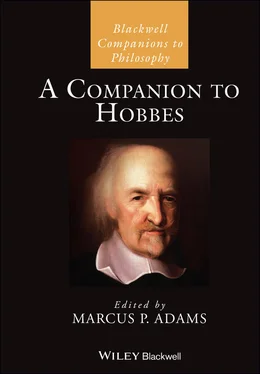Introduction: The Presentation and Structure of Thomas Hobbes’s Philosophy
MARCUS P. ADAMS
The shadow of Thomas Hobbes’s ideas stretches across the seventeenth century and continues to present day. His oeuvre ranges from translations of texts by figures such as Homer and Thucydides to the interpretation of Biblical texts, and from works devoted to geometry and optics to civil philosophy and religion. His impact in these and other areas was significant, even if in some cases his views functioned primarily as a foil. In Hobbes’s own time he was reviled as the “monster of Malmesbury” who threatened the Christian religion and failed to appreciate the rise of experimental philosophy. Regarding religion, Abraham Cowley put it succinctly in The True effigies of the monster of Malmesbury, or, Thomas Hobbes in his proper colours (1680) when asserting that “He that will Hobbes Applaud must first Blaspheme .” Similarly, Hobbes received no invitation to join the Royal Society, and he harshly criticized the experimental philosophy as lacking a method when saying “ingenuity is one thing and method [ ars ] is another. Here method is needed” (Hobbes 1985, 347). 1Given such vitriol, it should be no surprise that the term ‘Hobbist’ was often used pejoratively to identify all that was seen as wrong with and dangerous in Hobbes’s thought.
Many of Hobbes’s contemporaries recognized that these points of pressure on Hobbes’s ideas, as well as others, were not isolated cases; indeed, many saw these problems as symptoms resulting from the overall system of materialist philosophy that Hobbes was advancing. For example, although Hobbes’s extended disputes with John Wallis focused largely on issues in mathematics, Wallis also attacked Hobbes’s metaphysics because of its theological implications. 2Likewise, the wide range of topics in Hobbes’s exchanges with Bishop Bramhall shows the extent to which the worries of Hobbes’s critics were often founded upon Hobbes’s system and not upon what the twentieth-first century reader may, at first glance, see as distinct areas of Hobbes’s thought. 3Hobbes saw himself as offering a system of philosophy with interconnected parts, and his critics frequently attacked it as such.
Given the wide range of Hobbes’s writings, as well as the period of time over which Hobbes was actively writing, revising, and translating his own works, there are many entry points into his thought. For example, one could examine Hobbes by beginning with his early works and tracing the trajectory of his ideas as they developed through differing rhetorical contexts. Such an approach to understanding Hobbes has been greatly aided by some of the excellent resources recently made available to scholars, such as Noel Malcolm’s Clarendon edition of Leviathan (Hobbes 2012), which provides English (1651) and Latin (1668) facing pages of that work, and Deborah Baumgold’s Three-Text Edition of Thomas Hobbes’s Political Theory (Baumgold 2017), which offers side-by-side comparison of passages in Elements of Law , De cive , and Leviathan . Alongside close attention to textual details, this approach might also examine Hobbes’s preceding context and influences as well as his immediate context, such as his correspondence (Hobbes 1994b) or the notes on his works as they were in the process of being written, such as Robert Payne’s on De corpore held in the Chatsworth House Hobbes papers (Chatsworth A10).
Another approach to Hobbes’s ideas could excise key arguments, or parts of those arguments, from his corpus and examine them on their own philosophical merits with less attention to textual minutiae. Such a method would seek to offer something like a rational reconstruction, holding Hobbes subject to requirements such as logical consistency and deductive validity, and in doing so seek to provide the best possible picture of what Hobbes sought to demonstrate. Rather than accusing Hobbes of being misguided, or at times even sloppy in his argumentation, this way of engaging Hobbes might attempt to explain away interpretational difficulties here and there with the aim of constructing a philosophically palatable system. Even if it might depart at times from Hobbes’s own explicit statements, taking such an approach may help bring Hobbes’s philosophy to bear upon pressing present-day issues and potentially offer guidance about moral quandaries. 4
The present volume has been organized under the assumption that these two approaches to studying Hobbes, i.e., the textual/philological approach and the philosophical approach, are not mutually exclusive. 5Our attempts at understanding a figure like Hobbes are aided by close textual and philological engagement with the aim of trying to understanding what Hobbes might have been saying. But these efforts can also be helped by stepping back from the text, as it were, and probing his viewpoints philosophically with the aim of trying to understand what Hobbes should have been saying, what he was committed to in one area given his claims in another, and what import his ideas might have for us today.
Why feature Hobbes in a series like the Blackwell Companions to Philosophy , especially since the range of Hobbes’s works is so diverse? Would Hobbes have viewed himself primarily as a philosopher and not, say, as a humanist or mathematician? 6Hobbes did much beyond what today we call by the name ‘philosophy’, such as his labors, mentioned already, in translating works from Antiquity. However, the scope of Hobbes’s own definition of ‘philosophy’ in De corpore I.2 was incredibly broad insofar as it included any phenomenon where causes could be conceived, whether from actual causes to effects or from effects to possible causes (Hobbes 1981, 175; OL I.2). Given this definition of ‘philosophy,’ it is no surprise that Hobbes appealed to causes in contexts such as his geometry, with generative definitions like “a line is made from the motion of a point” (Hobbes 1981, 297; OL I.63), and to possible causes throughout his natural philosophy in De corpore Part IV. The appeal to causes is likewise prominent in his famous account in civil philosophy “Of the Causes, Generation, and Definition of a Common-wealth” (Hobbes 2012, 254; 1651, 85).
Given this definition that delineates philosophy from all else, it seems that Hobbes himself might have excluded some of his own works from philosophy since they failed to treat of causes. Indeed, he says in De corpore I.8 that “where there is no generation or no properties, then no philosophy can be known” (Hobbes 1981, 189; OL I.9). There Hobbes declares that natural history and political history are not part of philosophy because “such knowledge [ cognitio ] is either experience or authority, not reasoning” (Hobbes 1981, 189; OL I.9). Thus, at first glance it would seem that Hobbes’s definition of ‘philosophy’ excludes some of his own works, such as Behemoth; Or an Epitome of the Civil Wars of England, From 1640, to 1660 (2010) since it is prima facie a work of history.
Perhaps we might see such work as done in the service of philosophy rather than as a part of philosophy proper. After all, Hobbes himself admits that natural and civil histories are “very useful (no, indeed necessary) for philosophy” (Hobbes 1981, 189; OL I.9). However, his interests in the civil war of his own time, as well as historical work on prior times, were hardly mere preparatory work for some later philosophical project. Indeed, Behemoth was presented in dialogue form, something it has in common with polemical philosophical works such as Dialogus Physicus , with interlocutor A of Behemoth sometimes seeming to recount Hobbes’s view and others times B (see Hobbes 2010, 20ff). Concerning how the civil war came about, Hobbes tells Henry Bennet, Lord Arlington, that the first dialogue “contains the seed” of it and the second shows the “growth” (2010, 106), and at the outset of that dialogue, we find interlocutor B imploring to be enlightened with A’s vantage point of the civil war: “…I pray you set me (that could not then see so well) vpon the same mountaine by the relation of the actions you then saw, and of their causes, pretensions, iustice, order, artifice, and euent” (Hobbes 2010, 107). Hobbes’s other historical works likewise serve different polemical and rhetorical ends than mere preparatory work for philosophy and often interweave causal claims as he attempts to show not just that some event had happened but also tries to explain why it did. 7
Читать дальше












